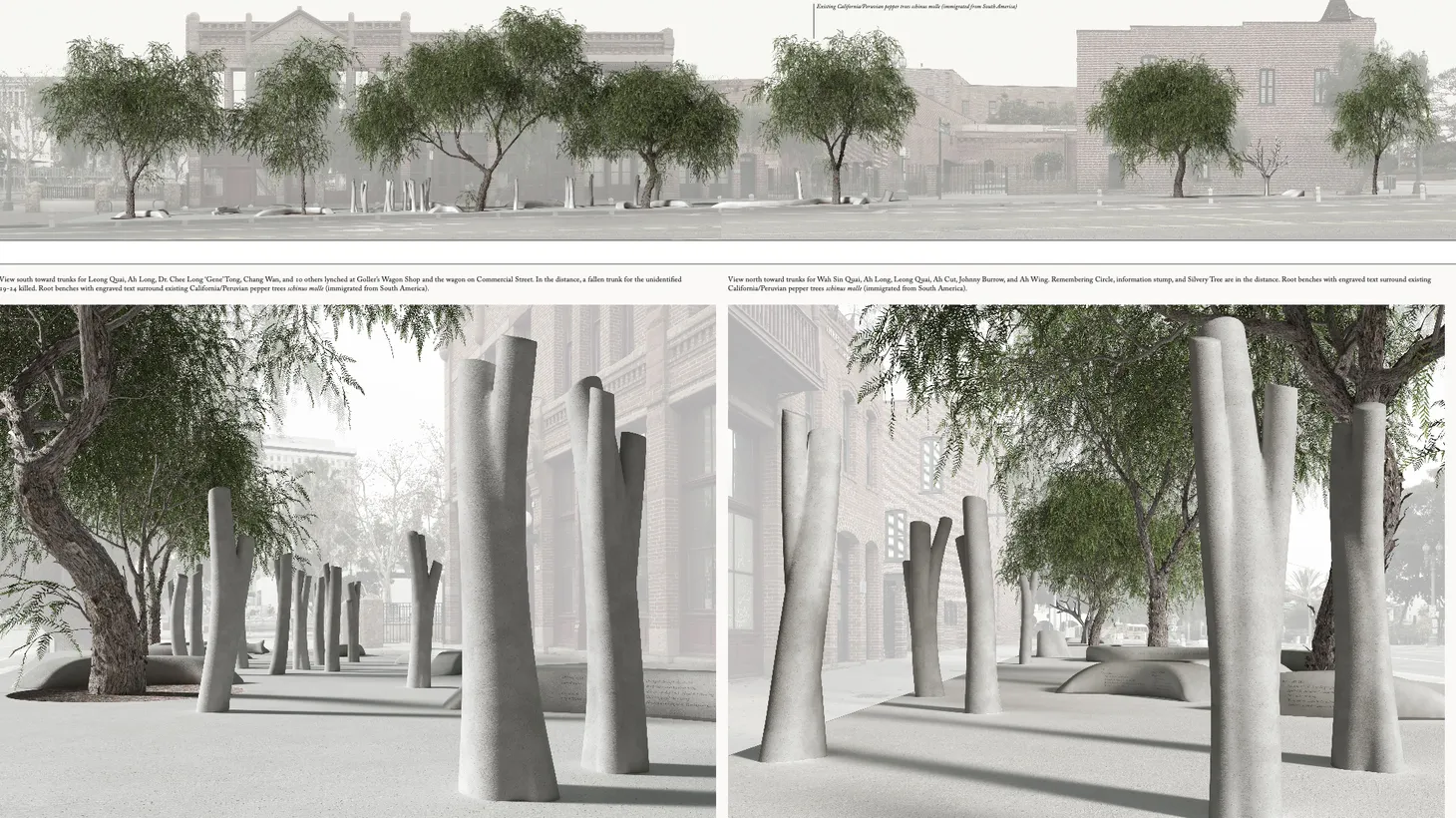One recent afternoon, museum board chair Gay Yuen bent down to read from a tiny plaque in the sidewalk in front of the Chinese American Museum on North Los Angeles Street in Downtown LA.
“On October 24, 1871, a mob of 500 locals shot, hung and stabbed innocent Chinese residents,” she reads aloud. “Nineteen Chinese living on Calle de los Negros were murdered.”
English speakers called Calle de los Negros “Negro Alley” — you can still find it on a few old city maps. It was named for the street’s original residents. Most of LA's original Spanish settlers had African blood.
Today, you can’t stand on Calle de los Negros to contemplate the violence that happened there — because Calle de los Negros doesn’t exist anymore. The plaque is the only remaining visible marker commemorating the most lethal act of racial violence in LA history. Yuen and others have been saying for years that the city can do better. And now it’s going to.
After a two-year discussion and design decision process, the LA Cultural Affairs Department announced on May 4, 2023 that they have chosen a memorial for the site designed by Sze Tsung Nicolás Leong and Judy Chui-Hua Chung.
Plans call for a sidewalk timeline of Asian immigrant contributions to American history in front of the Chinese American Museum. When the timeline reaches 1871, pedestrians will encounter 18 sculpted tree trunks, each with the name of a known victim, and a fallen tree to mark the unknown who were killed. Other stony stumps and a freeway mural will be placed nearby in parts of downtown with significant Asian American immigrant history.
“The recent rise of anti-Asian violence has had a long history,” Chung said when she and Leong presented their design proposal to the city in February. “The acceptance of Asians as Americans has been painful and incremental. Yet [the memorial] is a recognition that Asian Americans have been deeply rooted here in this city, state and country since the earliest days.”
The massacre
In 1871, Los Angeles was a western outback town with about 6,000 people, a six-man police force and a volatile stew of ethnic tensions.
“These were the years of the building of the transcontinental railroad,” Yuen tells KCRW. LA was home to “200 Chinese people, mostly single men trying to eke out a living and survive. Calle de los Negros was the hub of where these Chinese people lived and worked.”
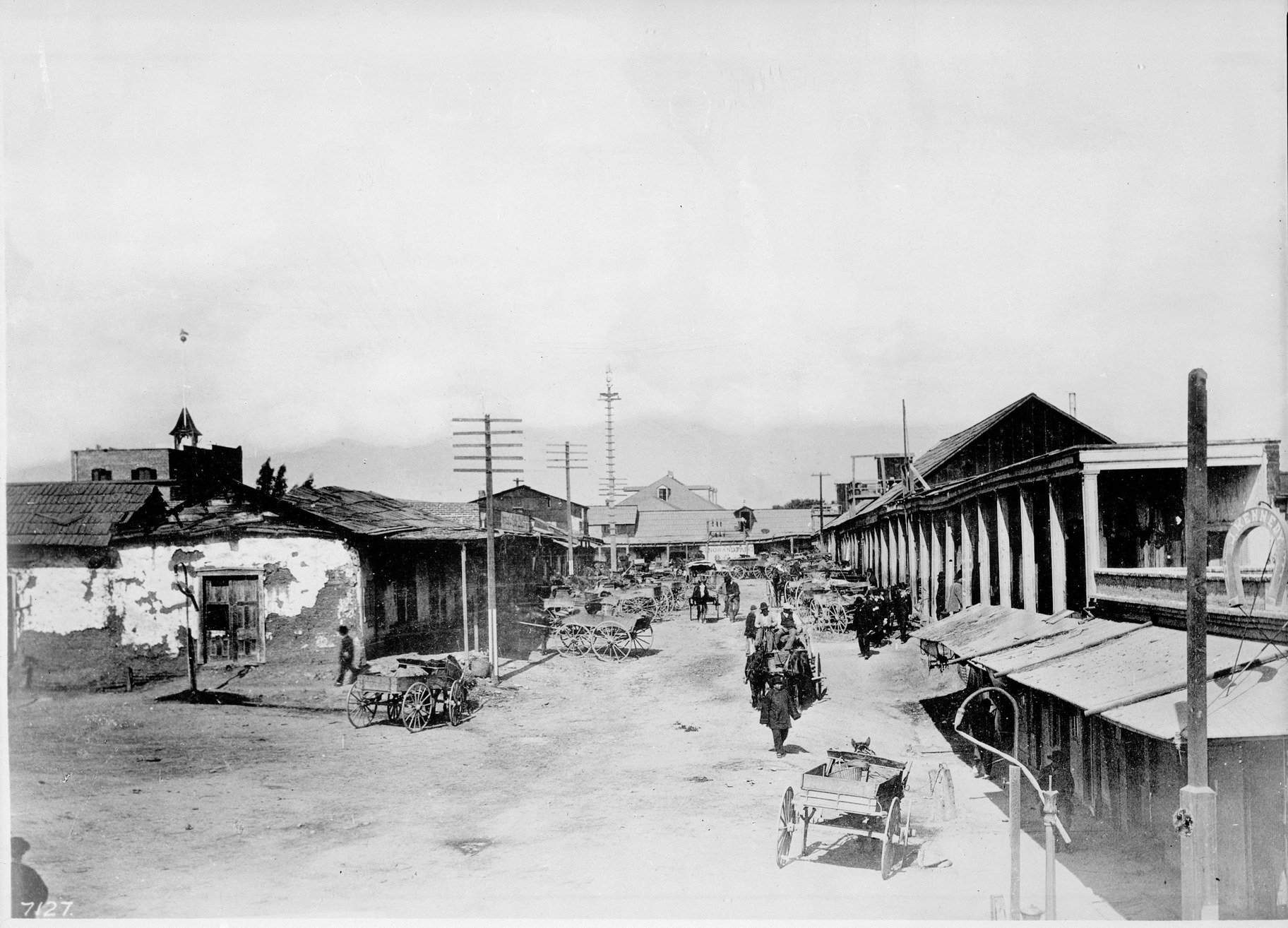
Calle de los Negros facing north (circa 1882). The street was home to most of the city’s Chinese population, which was over 200 by 1871. Photo courtesy of Los Angeles Public Library.
Calle de los Negros was also the city’s center of violence and vice, home to just about every brothel, bar, and gambling joint in town. Killings on the street weren’t uncommon here, but Yuen says, “I doubt there would have been a Chinese massacre had it not been a white person who walked into the middle of two Chinese men shooting it out over a woman.”
On October 24, 1871, as Chinese rivals battled in a gunfight over a female prostitute, a white former saloonkeeper decided to intervene. He shot into a Chinese store and was then immediately struck by return fire. He died an hour later.
“Word got out that Chinese people had shot a white man.” Yuen recounts. “Within hours, a mob of 500 came.
“People started raiding and lynching and shooting. Mob members going on top of buildings to chop holes on the roof, and then start shooting randomly down. That terror and that fear is overwhelming.”
By 11 p.m., the streets of downtown were quiet and empty. Eighteen Chinese men lay dead. Three days later, another would die from injuries, which is why some people count 19 massacre victims, while others, like Yuen, stop at 18.
“Those were the 18 names that appeared in the English newspapers,“ she explains. “There might be 20 who died, there might be 30, we’ll never know.”
A coroner’s inquest followed, then came arrests and murder trials. Nine men were eventually convicted of manslaughter. But one year later, the convictions were overturned on appeal. All nine killers were set free.
“The court didn’t care,” Yuen tells KCRW. “The case got thrown out because Chinese people can’t testify against white people. That was the law.”
Forgetting
Chinese Angelenos struggled in the aftermath of the murders. But the city was determined to move on.
The anti-Chinese massacre drew global headlines and bolstered the city’s reputation for lawlessness, says historian William Deverell. In response, the city re-branded itself.
“Los Angeles in the 1870s and 80s was a city very much on the make,” he says. “Its businesses, civic boosters, and political leaders were blanketing the world with images of the sunny Southland.”
For a city marketing itself as a suburban paradise full of orange groves and cool ocean breezes, a massacre was a terrible way to advertise.
And so in 1888, Calle de los Negros was voted out of existence by the Los Angeles City Council, while just a few feet away, North Los Angeles Street — which had already been around for decades — was extended two blocks to include the site of the violence.
“It’s urban growth,” says Deverell. “That part of downtown was going to be a kind of cacophony of transit.”
By the turn of the century, LA had become a boomtown of 102,000 people. The days of frontier justice were gone, along with all the old buildings, businesses, and people of Calle de los Negros. Civic memory of the massacre was disappearing as well. Today most Angelenos have never heard of the massacre.
Yuen says she first learned about it when she joined the museum board 15 years ago.
“I grew up in Chinatown, I studied Asian American history, I taught Asian American history. I never knew such a thing happened,” she says.
Now when she describes the massacre to Chinese Americans who grew up in the city, including second, third, even fourth-generation Angelenos, “The first thing you hear is ‘I never knew,’” she says. “The second thing: Their anger comes up. The anger I see when they say ‘I never knew.’ … We all have emotional scars.’ I chose to handle mine through education, and the museum is part of that education.”
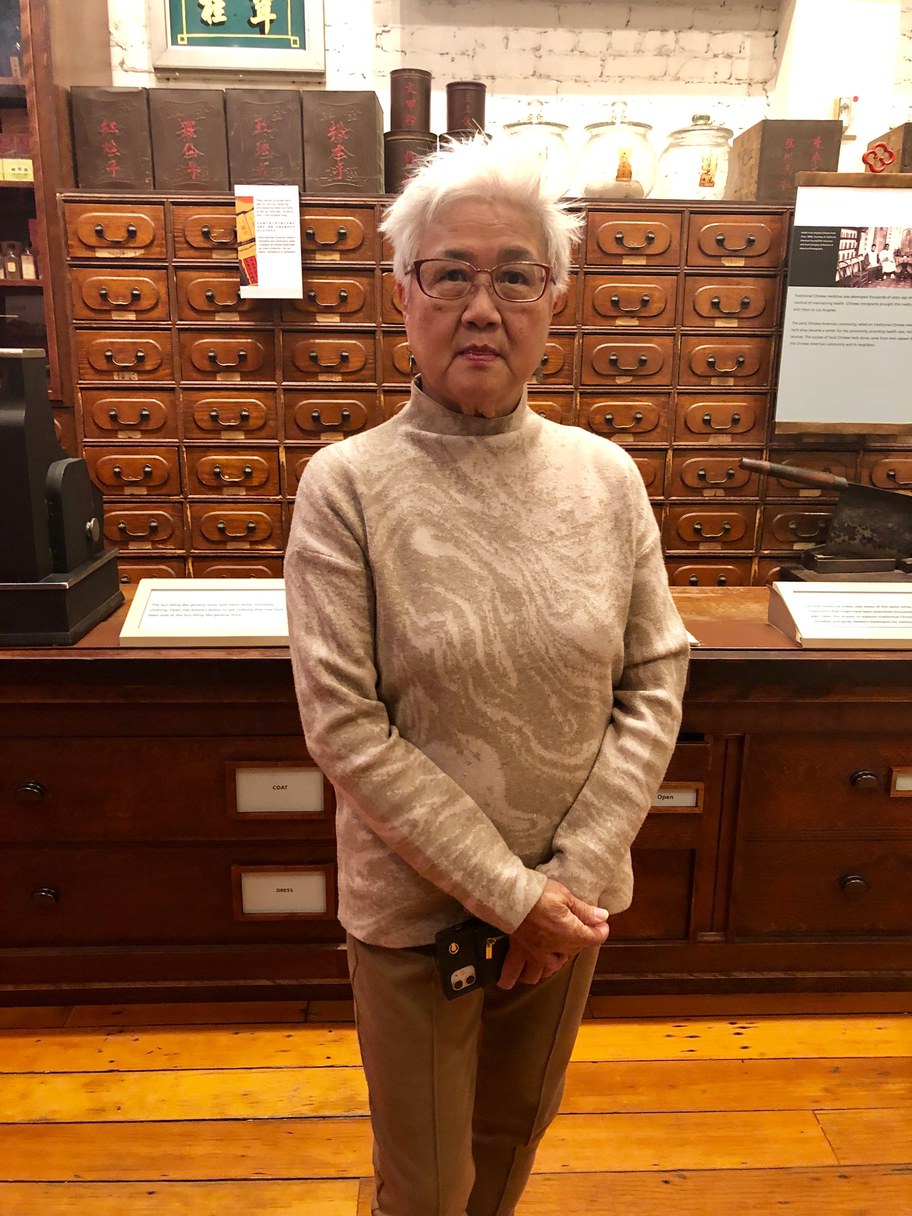
Dr. Gay Yuen is board chair of the city’s Chinese American Museum. “There are so many stories that are not told,” Yuen tells KCRW. “It doesn’t mean they can’t be told in the future, just that we have a lot of work to do.” Photo by Mike Schlitt.
Remembering
In 2011, the Chinese American Museum began to commemorate the massacre every year on its anniversary. That’s how the history came to the attention of Jason Chu, a Chinese American rapper and activist who grew up on the East Coast. Chu says he found the commemorations meaningful, so he kept coming back.
“It wasn't large gatherings,” he recalls, “but they kept doing it and people got wind of this and started realizing, ‘Hey, this is something that resonates with events that are happening now.’”
In 2020, “COVID-19 was a watershed moment in terms of Asian American racial existence,” he says. “It became ‘are you with or against us?’ And I think what the last three years have given us an odd sense of historical déjà vu. That led to this renewed restored civic memory.”
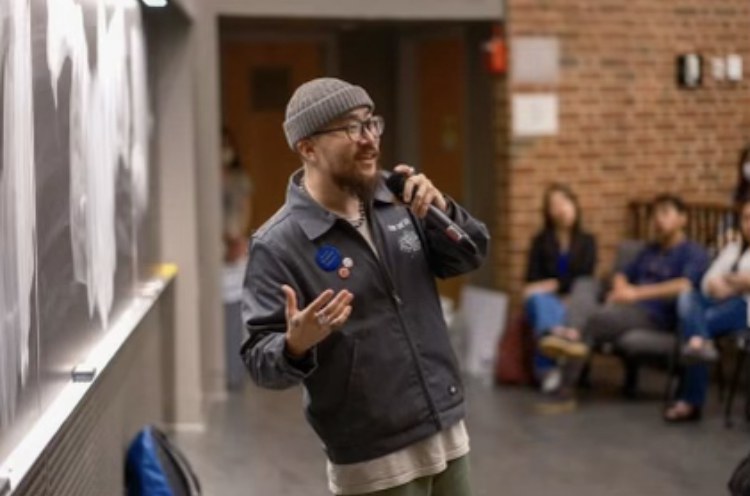
Jason Chu addresses the ECAASU student conference on Asian American history in April. “The goal of a memorial, in my opinion, is to transform the location, not only to say something happened, but to leave folks who visit with the question of what will happen.” says Chu. Photo by John Le.
On the massacre’s 150-year anniversary in 2021, former Mayor Eric Garcetti issued a public apology. He also convened 40 historians, architects, artists, curators, designers, and Indigenous elders and scholars to help the city “engage more productively with its past,” according to a mission statement from the panel, known as the Civic Memory Working Group.
Historian William Deverell is a member.
“We need to talk about the massacre, we need memorials to the victims of the massacre that are more than a plaque in a sidewalk that people stride over and have no idea is there,” he says.
A new, larger memorial is just one of 18 recommendations the working group made to the mayor’s office. That quickly led to the formation of a committee dedicated to making a memorial happen, co-chaired by Yuen.
Last fall, the committee put out a citywide open call for ideas and got back 180 proposals. Chu was part of a panel that chose the memorial design, and today they announced the winning design by Leong and Chung.
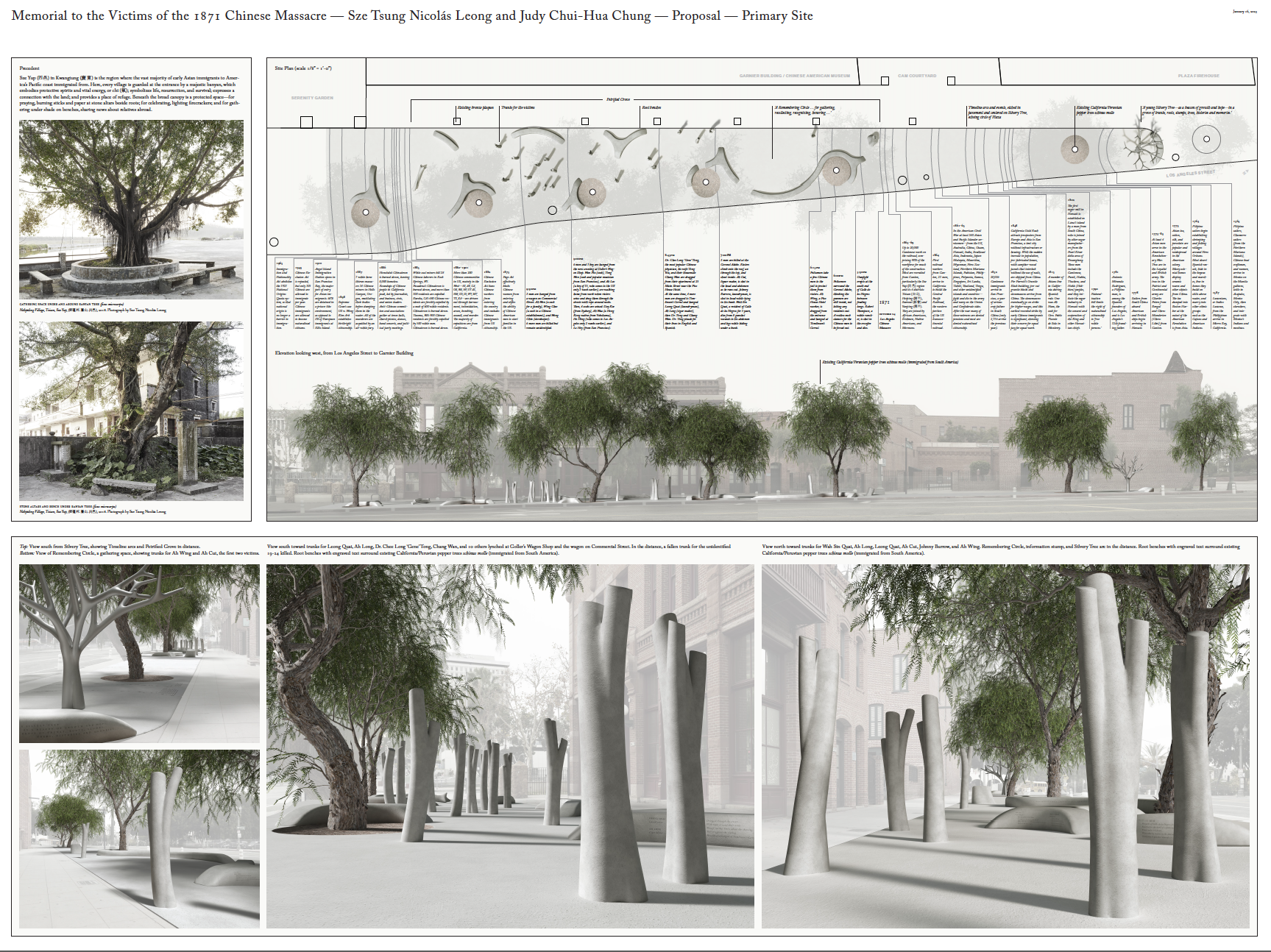
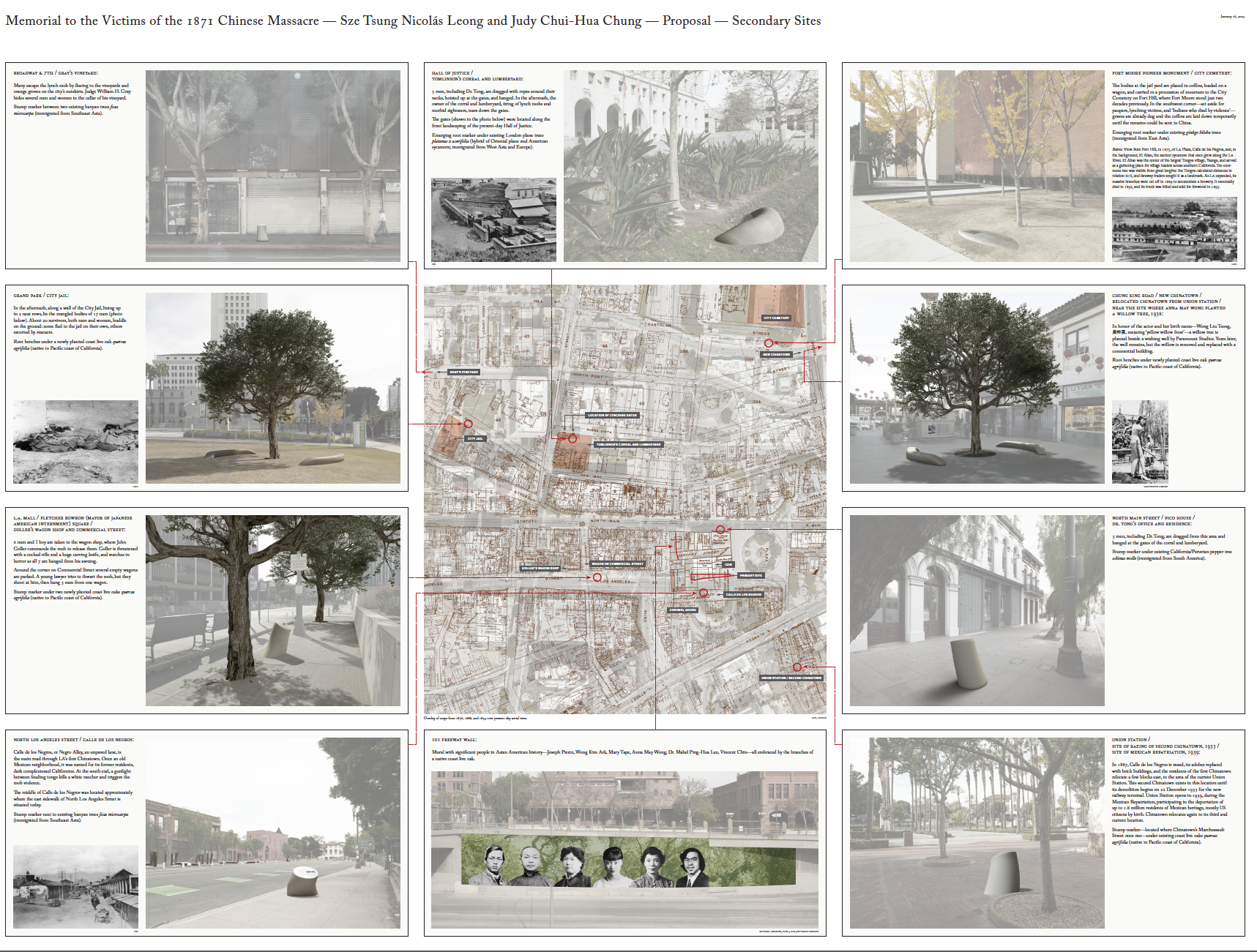
Photos courtesy of Los Angeles Department of Cultural Affairs.
Listen to the audio version that aired on May 3, 2023.
This story is part of Greater LA’s series on our city’s streets — how they got their names and what they say about past and present life here.
What’s in a street name: Olvera Street was meant to help poor Latinos survive
What’s in a street name? Why this extraordinary Black woman doesn’t have her own road sign
What’s in a street name: How PCH almost skipped Malibu
What’s in a street name? How a proposal to rename Crenshaw Boulevard divided the community
What’s in a street name? How ‘millionaire socialist’ built Wilshire Blvd
What’s in a street name? These people on Pico Blvd have a lot in common with Pio Pico

